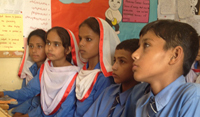 DIL’s instructional video production project was initiated in response to feedback from the Mobile Learning mid-project evaluation. Teachers showed the mobile videos to their students as an instructional tool and the students responded positively.
DIL’s instructional video production project was initiated in response to feedback from the Mobile Learning mid-project evaluation. Teachers showed the mobile videos to their students as an instructional tool and the students responded positively.
Hajra Saeed, a long-time DIL supporter, volunteered to do the instruction on the video using simple English (with a Pakistani-accent) at a slow pace. Ten videos were produced covering topics already introduced in the Class 6 curriculum guide and covered in the textbook. This was to ensure the topics taught in the videos would not be new information for the students, but rather a new method/delivery of the content, both through the video platform and the pedagogy Hajra used. The goal of these sessions was to get initial feedback from the students on these videos—both in terms of content and also attitudes toward the videos.

Students at two Rawalpindi schools were shown the videos. At the first school, Ranjali, the students were divided into small groups and at the second, Frash, they were shown the videos as a whole class. The videos were shown on a laptop held by the teacher to mimic the format that would be used in schools where only laptops are currently available without projectors.
The students at both schools reported that they were able to easily see and hear the videos. At the first school the videos ran straight through with no stops or teacher prompting and at the second Sadaf, Master Trainer English, paused the video to ask questions and elicit student responses. She also asked clarifying questions to ensure the students understood what Hajra was saying.
Students at both schools were very excited to watch videos. They all showed high levels of interest and did not lose concentration even when watching the longer videos.

The students at Frash watched two consecutive videos totaling nearly 20 minutes and didn’t show any signs of fatigue or boredom. When Sadaf paused the video to ask questions the students readily responded with correct answers. And one student at Frash was seen throughout the viewing mouthing words after Hajra said them practicing quietly how to make the sounds herself in English.
At the end of the videos the students were able to correctly answer questions about the content and give new examples applying the concepts taught by Hajra.
Remarkably, the majority of the students could understand a full lesson entirely in English. Students were also able to watch the videos concentrating carefully on what was being said, without the need to add animation or other visual features. The students all reported that the videos were enjoyable and helped them understand the topic more clearly.

The videos appear to be a good support to the students in learning the concepts taught in English. A comprehensive pilot testing of the videos is underway and will inform future video production for all of the core subjects.

